Enhancement of Bentonite Materials with Cement for Gamma-Ray Shielding Capability
Abstract
:1. Introduction
2. Materials and Methods
2.1. Shielding Parameters
2.2. Experiment
3. Results and Discussion
4. Conclusions
Author Contributions
Funding
Institutional Review Board Statement
Informed Consent Statement
Data Availability Statement
Conflicts of Interest
References
- Available online: https://www.neimagazine.com/news/newsconstruction-ofegypts-first-nuclear-plant-to-begin-in-(2021)-8100216 (accessed on 21 July 2021).
- Nnuka, E.; Enejor, C. Characterisation of Nahuta clay for industrial and commercial applications. Niger. J. Eng. Mater. 2001, 2, 9–12. [Google Scholar]
- Turner, J.E. Atoms, Radiation and Radiation Protection, 3rd ed.; John Wiley and Sons: New York, NY, USA, 2007. [Google Scholar]
- Knoll, G.F. Radiation Detection and Measurement, 3rd ed.; John Wiley and Sons: New York, NY, USA, 2000. [Google Scholar]
- Hall, E.J. Radiobiology for the Radiologist, 5th ed.; Lippincott Williams & Wilkins: Philadephia, NY, USA, 2000. [Google Scholar]
- Alkaya, D.; Esener, A.B. Usability of sand-bentonite-cement mixture in the construction of impermeable layer. Sci. Res. Essays 2011, 21, 4492–4503. [Google Scholar]
- Harjinder, S.M. Experimental investigation of clay fly-ash bricks for gammaray shielding. Nucl. Eng. Technol. 2016, 48, 1230–1236. [Google Scholar]
- Oto, B.; Gur, A. Gamma-ray shielding of concretes including magnetite in different rate. Int. J. Phys. Sci. 2013, 8, 310–314. [Google Scholar]
- Shamsan, S.O.; Sayyed, M.I.; Gaikwad, D.K.; Pawar, P.P. Attenuation coefficients and exposure buildup factor of some rocks for gamma ray shielding applications. Radiat. Phys. Chem. 2018, 148, 86–94. [Google Scholar]
- Sayyed, M.; Issa, S.A.; Büyükyıldız, M.; Dong, M. Determination of nuclear radiation shielding properties of some tellurite glasses using MCNP5 code. Radiat. Phys. Chem. 2018, 150, 1–8. [Google Scholar] [CrossRef]
- Taqi, A.H.; Khalil, H.J. Experimental and theoretical investigation of gamma attenuation of building materials. J. Nucl. Part. Phys. 2017, 7, 6–13. [Google Scholar]
- Sayyed, M.I.; Çelikbilek Ersundu, M.; Ersundu, A.E.; Lakshminarayana, G.; Kostka, P. Investigation of radiation shielding properties for MeOPbCl2-TeO2 (MeO ¼ Bi2O3, MoO3, Sb2O3, WO3, ZnO) glasses. Radiat. Phys. Chem. 2018, 144, 419–425. [Google Scholar] [CrossRef]
- Tekin, H.O.; Sayyed, M.; Manici, T.; Altunsoy, E.E. Photon shielding characterizations of bismuth modified borate -silicate-tellurite glasses using MCNPX Monte Carlo code. Mater. Chem. Phys. 2018, 211, 9–16. [Google Scholar] [CrossRef]
- Sayyed, M.; Lakshminarayana, G. Structural, thermal, optical features and shielding parameters investigations of optical glasses for gamma radiation shielding and defense applications. J. Noncryst. Solids 2018, 487, 53–59. [Google Scholar] [CrossRef]
- Dong, M.; Sayyed, M.; Lakshminarayana, G.; Çelikbilek Ersundu, M.; Ersundu, A.E.; Nayar, P.; Mahdi, M.A. Investigation of gamma radiation shielding properties of lithium zinc bismuth borate glasses using XCOM program and MCNP5 code. J. Noncryst. Solids 2017, 468, 12–16. [Google Scholar] [CrossRef]
- Kurudirek, M.; Chutithanapanon, N.; Laopaiboon, R.; Yenchai, C.; Bootjomchai, C. Effect of Bi2O3 on gamma ray shielding and structural properties of borosilicate glasses recycled from high pressure sodium lamp glass. J. Alloy. Compd. 2017, 745, 355–364. [Google Scholar] [CrossRef]
- Asal, S.; Erenturk, S.A.; Haciyakupoglu, S. Bentonite based ceramic materials from a perspective of gamma-ray shielding: Preparation, characterization and performance evaluation. Nucl. Eng. Technol. 2021, 53, 1634–1641. [Google Scholar] [CrossRef]
- Alharshan, G.; Aloraini, D.; Elzaher, M.; Badawi, M.; Alabsy, M.; Abbas, M.; El-Khatib, A. A comparative study between nano-cadmium oxide and lead oxide reinforced in high density polyethylene as gamma rays shielding composites. Nucl. Technol. Radiat. Prot. 2020, 35, 42–49. [Google Scholar] [CrossRef]
- Mahmoud, K.; Sayyed, M.; Tashlykov, O. Gamma ray shielding characteristics and exposure buildup factor for some natural rocks using MCNP-5 code. Nucl. Eng. Technol. 2019, 51, 1835–1841. [Google Scholar] [CrossRef]
- Kiani, M.A.; Ahmadi, S.J.; Outokesh, M.; Adeli, R.; Kiani, H. Study on physico-mechanical and gamma-ray shielding characteristics of new ternary nanocomposites. Appl. Radiat. Isot. 2019, 143, 141–148. [Google Scholar] [CrossRef]
- Rammah, Y.; Ali, A.; El-Mallawany, R.; El-Agawany, F. Fabrication, physical, optical characteristics and gamma-ray competence of novel bismo-borate glasses doped with Yb2O3 rare earth. Phys. B Condens. Matter 2020, 583, 412055. [Google Scholar] [CrossRef]
- Kurudirek, M. Photon buildup factors in some dosimetric materials for heterogeneous radiation sources. Radiat. Environ. Biophys. 2014, 53, 175–185. [Google Scholar] [CrossRef] [PubMed]
- Şakar, E.; Özpolat, Ö.F.; Alım, B.; Sayyed, M.I.; Kurudirek, M. hy-X/PSD: Development of a user friendly online software for calculation of parameters relevant to radiation shielding. Radiat. Phys. Chem. 2020, 166, 108496. [Google Scholar] [CrossRef]
- Hager, I.Z.; Rammah, Y.S.; Othman, H.A.; Ibrahim, E.M.; Hassan, S.F.; Sallam, F. Nano-structured natural bentonite clay coated by polyvinyl alcohol polymer for gamma rays attenuation. J. Theor. Appl. Phys. 2019, 13, 141–153. [Google Scholar] [CrossRef] [Green Version]
- Isfahani, H.S.; Abtahi, S.M.; Roshanzamir, M.A.; Shirani, A.; Hejazi, S.M. Investigation on gamma-ray shielding and permeability of clay-steel slag mixture. Bull. Int. Assoc. Eng. Geol. 2019, 78, 4589–4598. [Google Scholar] [CrossRef]
- Bashter, I. Calculation of radiation attenuation coefficients for shielding concretes. Ann. Nucl. Energy 1997, 24, 1389–1401. [Google Scholar] [CrossRef]
- Olukotun, S.; Gbenu, S.; Ibitoye, F.; Oladejo, O.; Shittu, H.; Fasasi, M.; Balogun, F. Investigation of gamma radiation shielding capability of two clay materials. Nucl. Eng. Technol. 2018, 50, 957–962. [Google Scholar] [CrossRef]
- Sharaf, J.; Saleh, H. Gamma-ray energy buildup factor calculations and shielding effects of some Jordanian building structures. Radiat. Phys. Chem. 2015, 110, 87–95. [Google Scholar] [CrossRef]
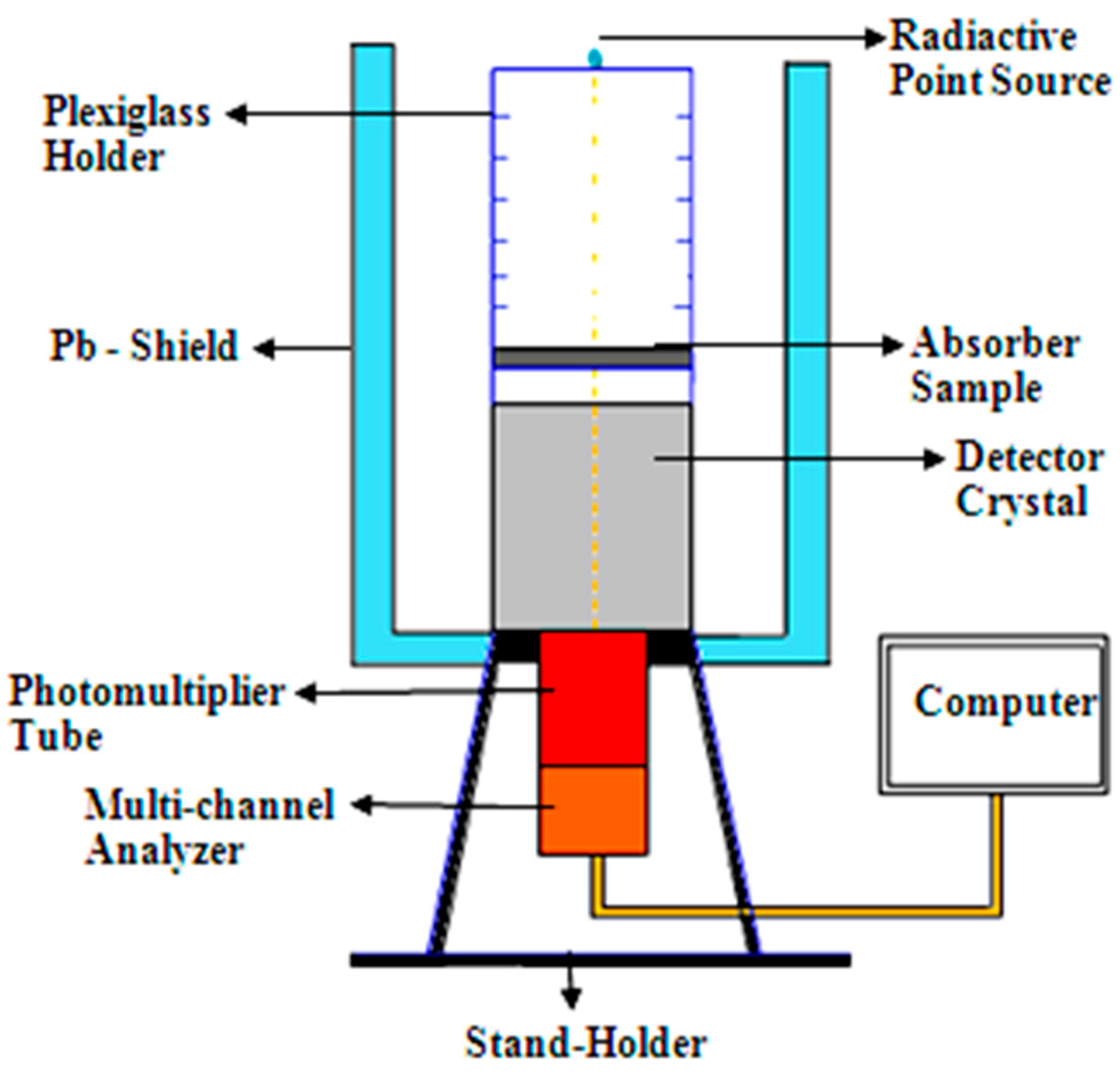
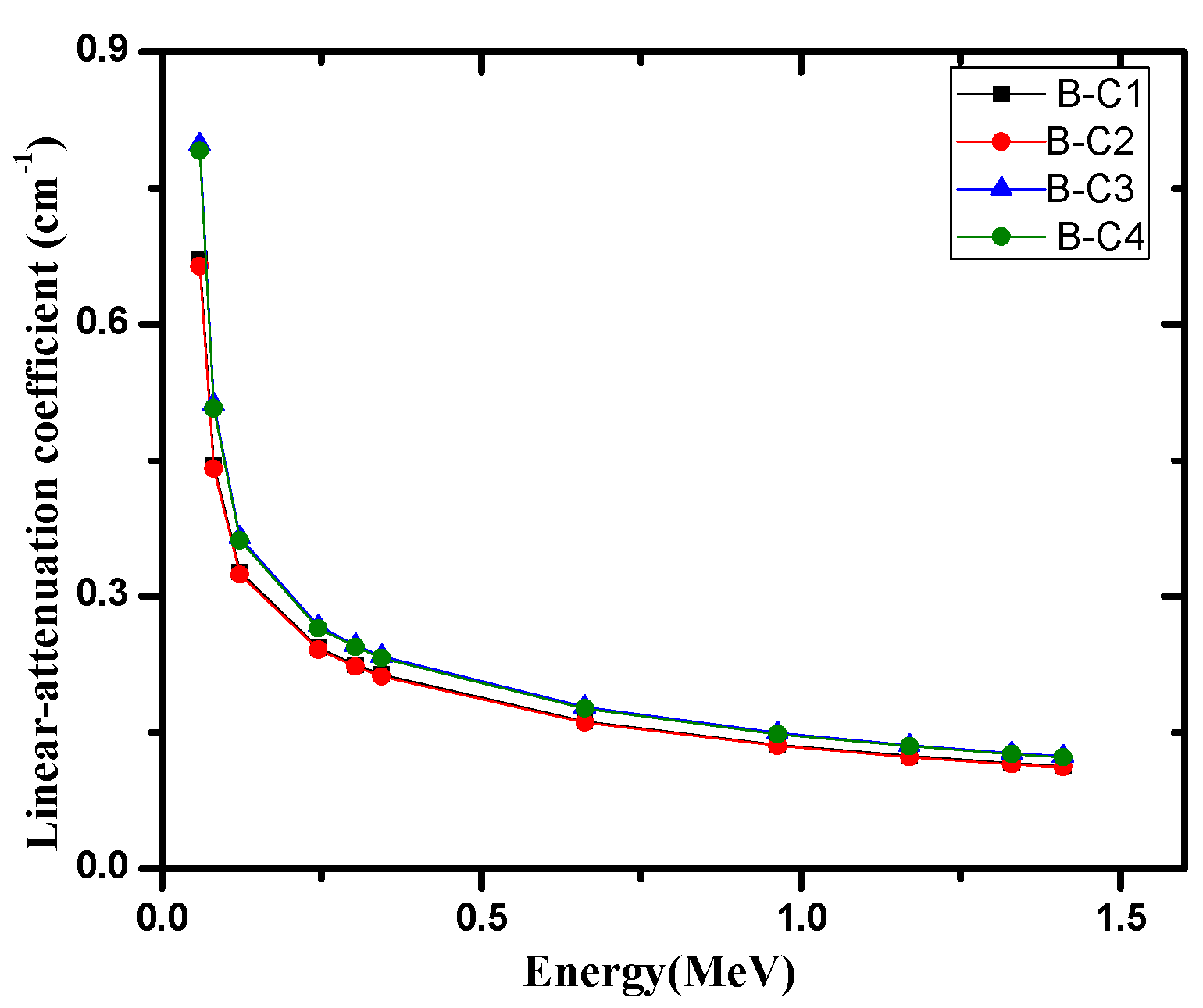

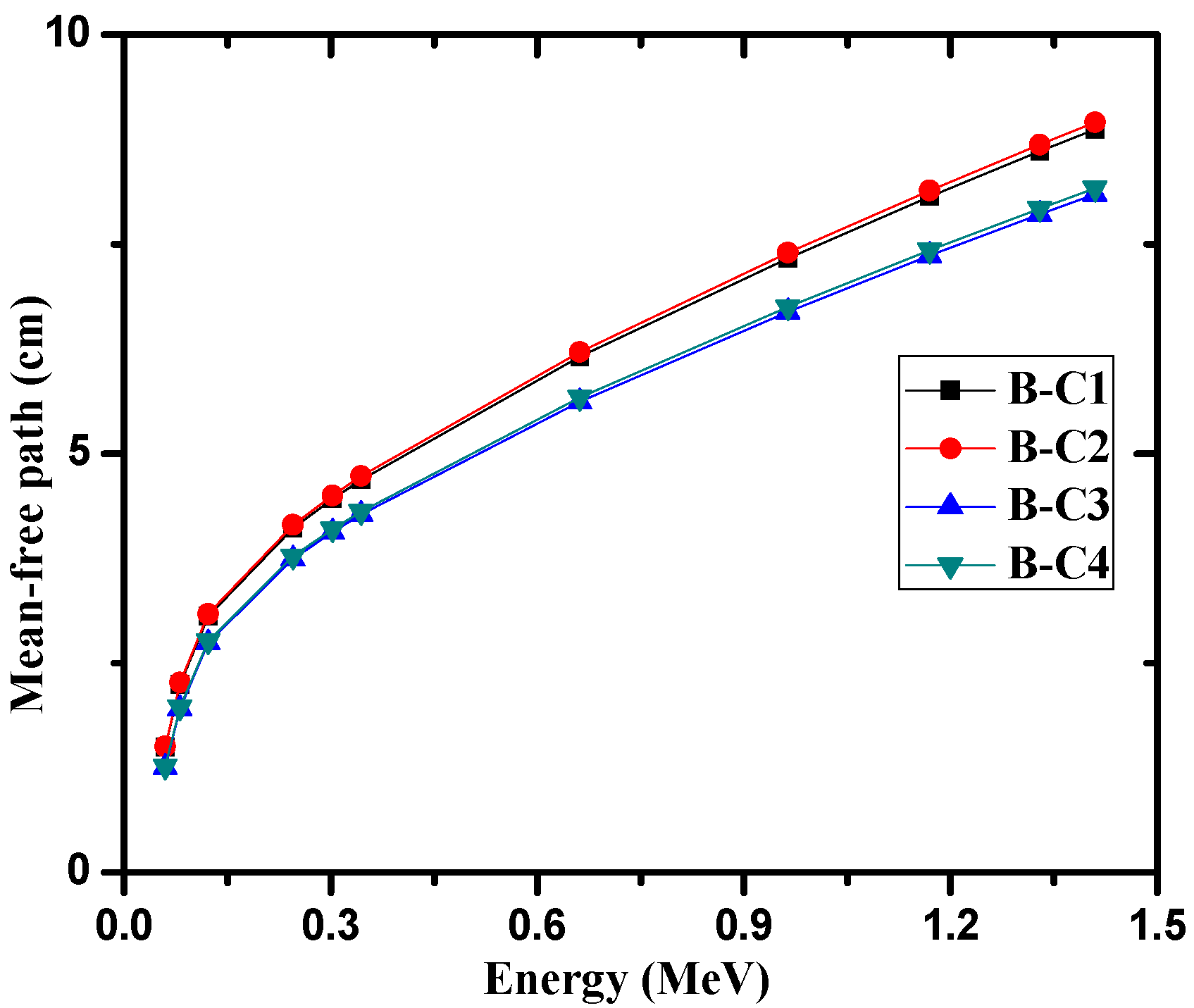
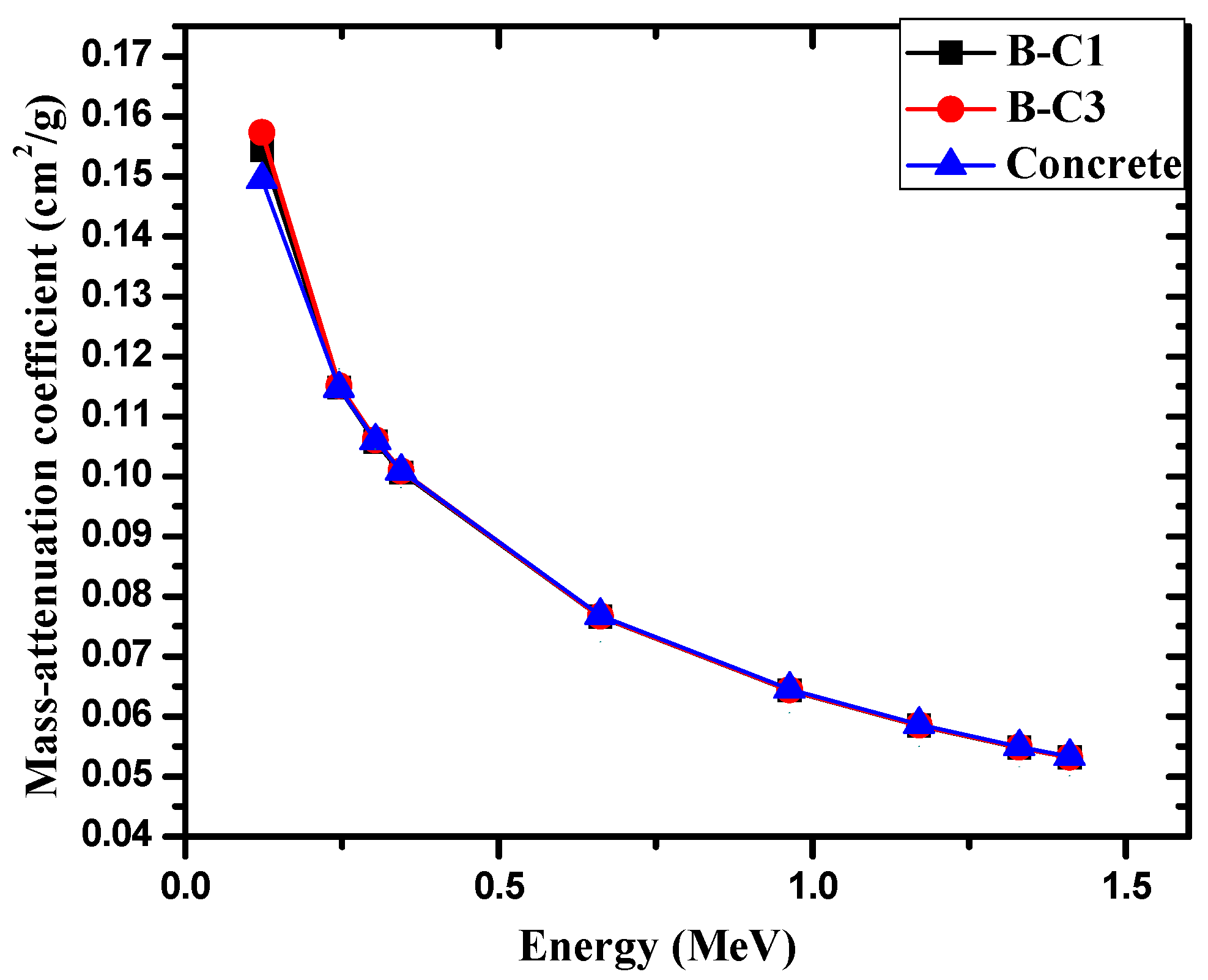
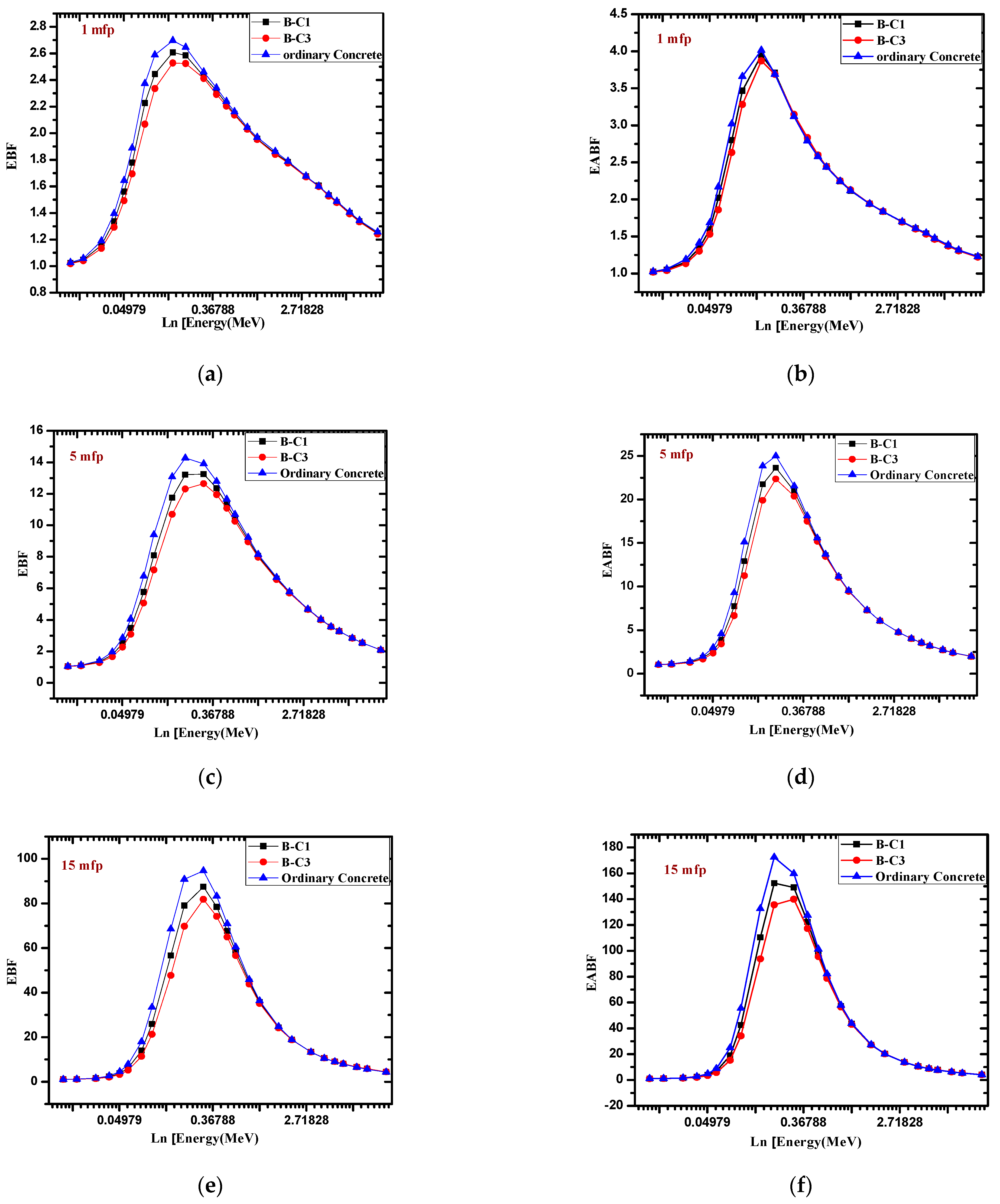
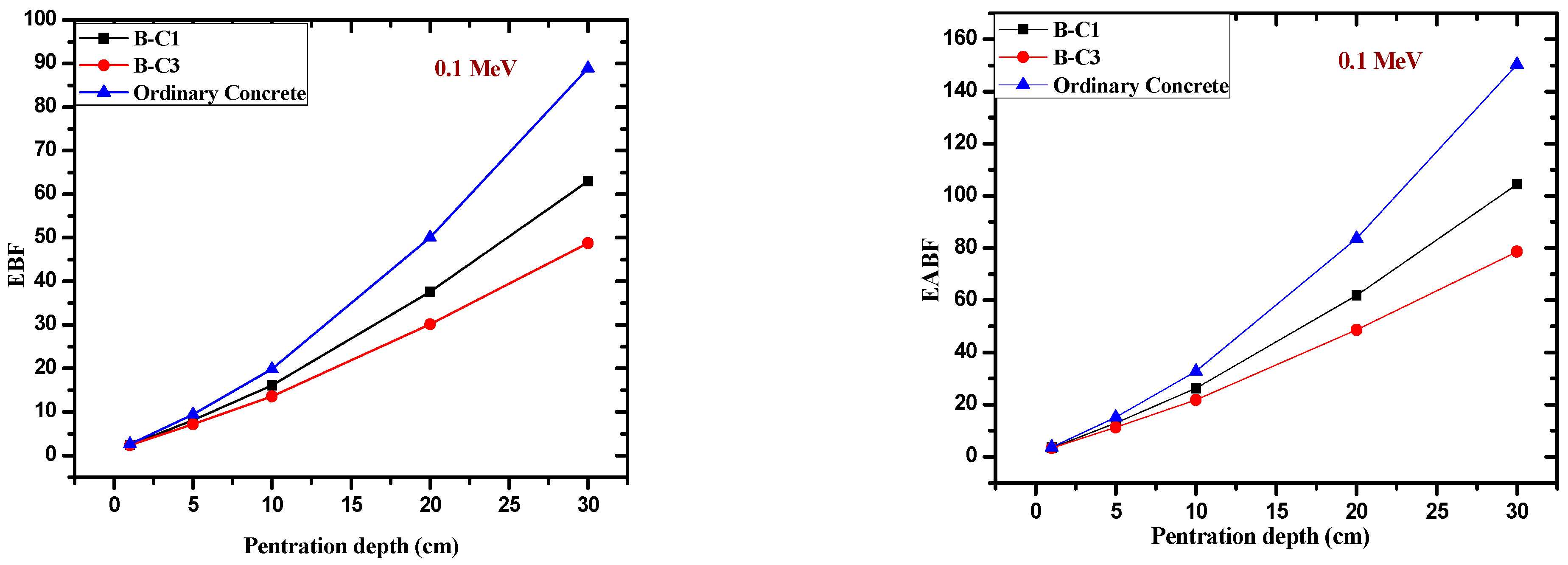
| Component | SampleB-C1 Density (g/cm3) = 2.12 Mass (%) | SampleB-C2 Density (g/cm3) = 2.10 Mass (%) | SampleB-C3 Density (g/cm3) = 2.32 Mass (%) | SampleB-C1 Density (g/cm3) = 2.30 Mass (%) |
|---|---|---|---|---|
| SiO2 | 49.490 | 49.543 | 41.430 | 41.494 |
| Al2O3 | 14.273 | 14.261 | 11.795 | 11.785 |
| CaO | 25.370 | 25.375 | 36.590 | 36.598 |
| Fe2O3 | 3.780 | 3.773 | 3.660 | 3.652 |
| SO3 | 0.642 | 0.622 | 1.070 | 1.033 |
| Na2O | 2.325 | 2.323 | 1.675 | 1.674 |
| MgO | 2.321 | 2.317 | 2.275 | 2.270 |
| TiO | 0.087 | 0.085 | 0.145 | 0.142 |
| K2O | 1.712 | 1.701 | 1.360 | 1.351 |
| Total | 100.00 | 100.00 | 100.00 | 100.00 |
| Reference Date | Energy keV | Activity kBq | Uncertainty kBq | Emission Probability % | PTB Nuclide |
|---|---|---|---|---|---|
| 1 June 2009 | 59.52 | 259.0 | ±2.6 | 35.9 | 241Am |
| 80.99 | 275.3 | ±2.8 | 34.1 | 133Ba | |
| 121.78 | 290.0 | ±4.0 | 28.4 | 152Eu | |
| 244.69 | 7.49 | ||||
| 344.28 | 26.6 | ||||
| 964.13 | 14.0 | ||||
| 1408.01 | 20.87 | ||||
| 661.66 | 385.0 | ±4.0 | 85.21 | 137Cs | |
| 1173.23 | 212.1 | ±1.5 | 99.9 | 60Co | |
| 1332.50 | 99.982 |
| Energy (keV) | Experimental μm (cm2/g) | Theoretical μm (cm2/g) | ||||||
|---|---|---|---|---|---|---|---|---|
| B-C1 | B-C2 | B-C3 | B-C4 | B-C1 | B-C2 | B-C3 | B-C4 | |
| 59.53 | 0.3130 ± 0.0021 | 0.3129 ± 0.0019 | 0.3398 ± 0.0020 | 0.3455 ± 0.0028 | 0.3162 | 0.3162 | 0.3441 | 0.3440 |
| 80.99 | 0.2068 ± 0.0020 | 0.2059 ± 0.0025 | 0.2162 ± 0.0025 | 0.2218 ± 0.0021 | 0.2100 | 0.2099 | 0.2206 | 0.2205 |
| 121.78 | 0.1528 ± 0.0022 | 0.1511 ± 0.0018 | 0.1554 ± 0.0021 | 0.1582 ± 0.0022 | 0.1543 | 0.1543 | 0.1573 | 0.1573 |
| 244.69 | 0.1138 ± 0.0025 | 0.1134 ± 0.0032 | 0.1145 ± 0.0027 | 0.1153 ± 0.0027 | 0.1148 | 0.1148 | 0.1151 | 0.1151 |
| 302.85 | 0.1045 ± 0.0030 | 0.1053 ± 0.0019 | 0.1060 ± 0.0028 | 0.1061 ± 0.0034 | 0.1058 | 0.1058 | 0.1061 | 0.1061 |
| 344.28 | 0.1003 ± 0.0031 | 0.1017 ± 0.0024 | 0.1007 ± 0.0028 | 0.1010 ± 0.0024 | 0.1007 | 0.1007 | 0.1009 | 0.1009 |
| 661.66 | 0.0763 ± 0.0028 | 0.0763 ± 0.0028 | 0.0767 ± 0.0031 | 0.0774 ± 0.0027 | 0.0766 | 0.0766 | 0.0767 | 0.0767 |
| 964.13 | 0.0639 ± 0.0025 | 0.0643 ± 0.0027 | 0.0644 ± 0.0035 | 0.0637 ± 0.0029 | 0.0644 | 0.0644 | 0.0644 | 0.0644 |
| 1173.23 | 0.0580 ± 0.0025 | 0.0580 ± 0.0029 | 0.0580 ± 0.0032 | 0.0584 ± 0.0032 | 0.0585 | 0.0585 | 0.0585 | 0.0585 |
| 1332.5 | 0.0547 ± 0.0027 | 0.0542 ± 0.0031 | 0.0547 ± 0.0031 | 0.0544 ± 0.0020 | 0.0548 | 0.0548 | 0.0549 | 0.0549 |
| 1408.01 | 0.0527 ± 0.0030 | 0.0529 ± 0.0024 | 0.0527 ± 0.0020 | 0.0526 ± 0.0028 | 0.0532 | 0.0532 | 0.0532 | 0.0532 |
| Absorber Sample | Density (g/cm3) | 1.173 MeV | 1.332 MeV | |||||||
|---|---|---|---|---|---|---|---|---|---|---|
| μm (cm2/g) | μ (cm−1) | HVL (cm) | TVL (cm) | μm (cm2/g) | μ (cm−1) | HVL (cm) | TVL (cm) | |||
| [24] | Natural bentonite | 0.85 | 0.061 | 0.052 | 13.330 | 44.280 | 0.049 | 0.049 | 14.146 | 46.991 |
| [25] | Bentonite with steel slag | 1.98 | 0.056 | 0.110 | 6.300 | 20.936 | 0.050 | 0.100 | 6.930 | 23.026 |
| [26] | Ordinary concrete | 2.30 | 0.059 | 0.137 | 5.072 | 16.835 | 0.056 | 0.128 | 5.419 | 17.986 |
| Steel scrap | 4.00 | 0.057 | 0.228 | 3.034 | 10.070 | 0.054 | 0.214 | 3.238 | 10.748 | |
| [27] | Ball clay | 1.99 | 0.060 | 0.120 | 5.794 | 19.231 | 0.057 | 0.112 | 6.164 | 20.456 |
| Kaolin clay | 1.99 | 0.060 | 0.120 | 5.794 | 19.231 | 0.057 | 0.112 | 6.164 | 20.456 | |
| Current work | B-C3 | 2.32 | 0.058 | 0.136 | 5.111 | 16.964 | 0.055 | 0.127 | 5.455 | 18.104 |
| B-C1 | 2.12 | 0.058 | 0.124 | 5.590 | 18.552 | 0.055 | 0.116 | 5.965 | 19.798 | |
Publisher’s Note: MDPI stays neutral with regard to jurisdictional claims in published maps and institutional affiliations. |
© 2021 by the authors. Licensee MDPI, Basel, Switzerland. This article is an open access article distributed under the terms and conditions of the Creative Commons Attribution (CC BY) license (https://creativecommons.org/licenses/by/4.0/).
Share and Cite
El-Khatib, A.M.; Elsafi, M.; Almutiri, M.N.; Mahmoud, R.M.M.; Alzahrani, J.S.; Sayyed, M.I.; Abbas, M.I. Enhancement of Bentonite Materials with Cement for Gamma-Ray Shielding Capability. Materials 2021, 14, 4697. https://doi.org/10.3390/ma14164697
El-Khatib AM, Elsafi M, Almutiri MN, Mahmoud RMM, Alzahrani JS, Sayyed MI, Abbas MI. Enhancement of Bentonite Materials with Cement for Gamma-Ray Shielding Capability. Materials. 2021; 14(16):4697. https://doi.org/10.3390/ma14164697
Chicago/Turabian StyleEl-Khatib, Ahmed M., Mohamed Elsafi, Mohamed N. Almutiri, R. M. M. Mahmoud, Jamila S. Alzahrani, M. I. Sayyed, and Mahmoud I. Abbas. 2021. "Enhancement of Bentonite Materials with Cement for Gamma-Ray Shielding Capability" Materials 14, no. 16: 4697. https://doi.org/10.3390/ma14164697
APA StyleEl-Khatib, A. M., Elsafi, M., Almutiri, M. N., Mahmoud, R. M. M., Alzahrani, J. S., Sayyed, M. I., & Abbas, M. I. (2021). Enhancement of Bentonite Materials with Cement for Gamma-Ray Shielding Capability. Materials, 14(16), 4697. https://doi.org/10.3390/ma14164697









